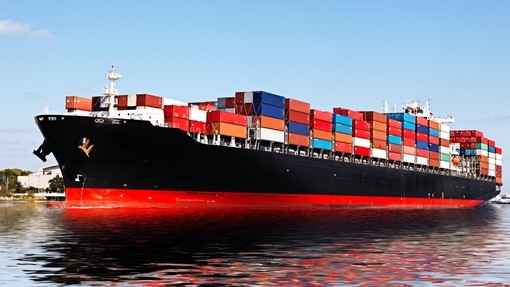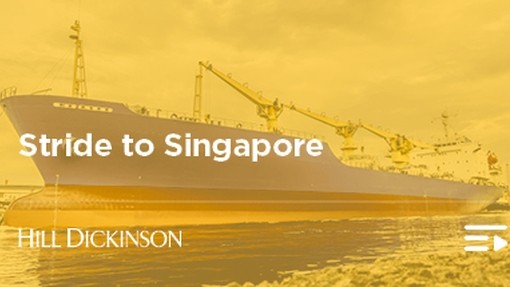UK ports and coronavirus - employment considerations

Details
During this rather unusual and challenging time, UK ports are under incredible pressures both to ensure critical business operations continue and to support and maintain their workforces in doing so.
The WHO (World Health Organization) declared COVID-19 (coronavirus) a pandemic on 11 March 2020. Just three weeks on, with all major economies in lockdown, a realistic worst-case scenario involves up to 80% of the population catching the virus, with the bulk of these cases falling within a window running from mid-April to mid-June 2020.
UK lockdown
To reduce the spread of COVID-19, on Monday 23 March 2020, the UK government introduced three measures:
- Requiring people to stay at home, except for very limited purposes
- Closing certain businesses and venues
- Stopping all gatherings of more than two people in public
Schools, nurseries and colleges closed on Friday 20 March 2020 to all but the children of ‘key workers’ and those deemed vulnerable. The Department for Education described ‘key workers’ as work which is critical to the COVID-19 response; or work in critical sectors, including:
- Food and other necessary goods – this includes those involved in food production, processing, distribution, sale and delivery, as well as those essential to the provision of other key goods (for example hygienic and veterinary medicines; and
- Transport – this includes those who will keep the air, water, road and rail passenger and freight transport modes operating during the COVID-19 response, including those working on transport systems through which supply chains pass
As such, many of those working at UK ports are considered to have ‘key worker’ status, which provides an exception to the government’s strict social distancing guidance to stay at home, and permits travel for work purposes (but only where work cannot be performed from home). It should be noted that the Department for Education’s key worker list has been adopted in England, Wales and Northern Ireland. Those individuals working in ports in Scotland may fall under a ‘Category 2’ or ‘Category 3’ key worker, in accordance with the Scottish government’s guidance but the decision to provide and prioritise education services for key workers is being taken at local authority level with employers being encouraged ‘to think critically about which staff are considered to be key workers, and to ruthlessly prioritise those providing absolutely essential services to the public in these emergency times’.
Sickness/self-isolation payments
The starting point for employers should be to minimise, so far as possible, the risk of workers bringing coronavirus infection with them to work. If workers attend work whilst symptomatic, or when they ought to be self-isolating, then the chances of them infecting colleagues, particularly at a port, is significant.
Workers should be instructed to follow the government’s current self-isolation guidance, which is to self-isolate for seven days for those with a persistent cough or fever (or for the whole household to self-isolate for 14 days if any member has these symptoms). If a worker meeting this criteria attends work, they should immediately be sent home to self-isolate.
Currently, if a worker in England (although we understand that mirror regulations have now also been passed in Northern Ireland, Scotland and Wales) is ordinarily eligible for statutory sick pay (SSP), it will be payable if they are:
- Incapacitated due to injury or illness (i.e. symptomatic)
- Deemed to be incapacitated despite being ‘capable’ of work because one of the following applies:
- they are self-isolating for 7 or 14 days in accordance with the online self-isolation guidance
- NHS 111 or a doctor advises an employee to self-isolate due to coronavirus (this can be orally or in writing, but should be followed up with a self-isolation notice if oral)
- a doctor states that the employee should not work for precautionary or convalescent reasons
- excluded from work on a certificate from a medical officer for environmental health and are under medical observation because they are a carrier of, or have been in contact with, an infectious disease
Traditionally, an employee is not eligible for SSP for the first three days (known as ‘waiting days’), however new regulations came into force on 28 March 2020, which mean an employee who is actually or deemed incapacitated, because of coronavirus, can claim SSP from on the first day of absence.
A worker who merely chooses to self-isolate in circumstances where none of the above requirements are met (e.g. because they are afraid or because a member of their household is considered to be ‘at a higher risk’) is not entitled to statutory or contractual sick pay. However, an employer should exercise a degree of discretion when dealing with such a worker (e.g. they might have genuinely misinterpreted the government guidance) and should check that they are not seeking to take a different kind of leave e.g. dependant care leave. The SSP rules have been amended to cover people who are self-isolating for 14 days, if they live in the same household as someone who displays coronavirus symptoms. If a dependant does not live in the same household as an employee, it is likely they will be eligible to take dependant care leave. This allows an employee to take a reasonable amount of unpaid leave to take necessary action when a dependant falls ill or dies. However, some contracts allow the employee: (a) paid dependent care leave; or (b) to take their own contractual sick pay when a dependant falls ill.
The questions as to whether or not an employer should pay an employee who is self-isolating contractual sick pay is dependent on the precise wording of any contractual sick pay provisions in the contract. Many employers appear to take the view that a non-symptomatic worker in self-isolation should not receive full company sick pay. However, it is very difficult to argue that a worker is not entitled because they are not symptomatic, in circumstances were SSP regulations ‘deem’ them to be ‘incapacitated’ in the circumstances outlined above.
Continuing operations
With a likely increase in sickness absence levels amongst the workforce, employers at UK ports will need to consider:
- Which roles can be performed remotely, and put measures in place to support agile and flexible working
- If working remotely is not possible, unaffected ‘key workers’ should be expected to perform their duties as normal (with reference to social distancing guidance and PPE if necessary)
- If business should continue to operate with a skeleton workforce only
- If home-working is not an option consider:
- advising, or instructing, affected staff to use their annual leave during the period of emergency measures (which will also make them available to work later in the holiday year
- asking (or if contracts allow for temporary lay-offs, instructing) staff to take an agreed period of unpaid leave (‘layoff’)
- ‘furloughing’ (see below)
- Placing restrictions on annual leave for unaffected ‘key workers’ (within those permitted by any employment contract and Working Time Regulations 1988) will help to make staff available during the peak of coronavirus disturbances
- If the number of agency, temporary and casual staff can be reduced to cut costs
Furlough and other business support mechanisms
On Friday 20 March 2020, the chancellor announced a new package of business support measures to help business during the economic crisis created by coronavirus (see table which follows). An important part of the package is the Coronavirus Job Retention Scheme (or ‘furlough leave’). Furlough leave is a temporary leave of absence for economic reasons and is designed to save jobs. At this stage, we only have limited details of the scheme, provided through HMRC guidance but the key features are:
- An employee can be placed on ‘furlough leave’ instead of being dismissed or laid off
- The employee will remain on the payroll and continue to accrue continuous service/annual leave
- HMRC will reimburse 80% of furloughed workers’ wage costs (capped at £2,500 per month) plus employer’s NICs and minimum automatic enrolment employer pension contributions on that wage
- Fees, commission and bonuses should not be included in the 80% furlough reimbursement
- The employer can choose to top the 80% up to full pay
- The furlough scheme is open to all UK employers that had created and started a PAYE payroll scheme on 28 February 2020
- The furloughed employee must have been on your PAYE payroll on 28 February 2020
- Payments can be backdated to 1 March (but reimbursement will not apply to periods of active work after that date)
- The scheme will initially run until 31 May 2020, but may be extended
- The minimum period of furlough leave is three weeks (and it does not appear that an employer will be able to recall an employee during this time and reclaim payments as ‘furlough’)
- Payments are expected to be available from the end of April (date not confirmed)
- HMRC are working urgently to set up a system for reimbursement, because their existing systems are not set up to facilitate payments to employers
- Employer must submit information to HMRC confirming which employees have been put on furlough leave and their earnings through a new online portal (HMRC yet to confirm details)
Specialist employment advice should be taken before steps are taken to ‘furlough’ employees as employers need to be mindful of both their statutory and contractual obligations.
| All businesses | |
| What support? | Eligibility |
Furlough leave HMRC will reimburse 80% of furloughed workers’ wage costs, up to a cap of £2500 per month. HMRC are working urgently to set up a system for reimbursement. Existing systems are not set up to facilitate payments to employers. | Must designate affected employees as ‘furloughed workers,’ (this will probably need to be agreed with employee as temporary contract change). Must submit information to HMRC about the employees that have been furloughed and their earnings through a new online portal (HMRC yet to confirm details). |
Deferred VAT Valued Added Tax (VAT) payments deferred for three months. | All UK businesses are eligible. For VAT, the deferral will apply from 20 March 2020 until 30 June 2020. Automatic; no applications required. Do not need to make a VAT payment during this period. |
Time to Pay service Deferral of any tax liability agreed with HMRC on case-by-case basis. | Pay tax to UK government and have outstanding liability. |
| SMEs (less than 250 staff) - any sector | |
| What support? | Eligibility |
SSP recovery for COVID-19 absence Up to two weeks’ SSP per eligible employee who has been off work because of COVID-19. Eligible period for the scheme will commence the day after the regulations on the extension of SSP to those staying at home came into force. Repayment mechanism to be announced. | SMEs will have any SSP paid for sickness absence due to COVID-19 reimbursed. The eligibility criteria for the scheme will be as follows:
|
Small business grant scheme Cash grants of up to £10,000 per business. | Small businesses that pay little or no business rates and are eligible for small business rate relief (SBBR) or rural rate relief (RRR). Will be contacted by their local authority - they do not need to apply. The funding will be provided to local authorities in early April. |
Coronavirus Business Interruption Loan A new temporary Coronavirus Business Interruption Loan Scheme, delivered by the British Business Bank, will launch soon to support primarily small and medium-sized businesses to access bank lending and overdrafts. The government will provide lenders with a guarantee of 80% on each loan (subject to a per-lender cap on claims) to give lenders further confidence in continuing to provide finance to SMEs. The government will not charge businesses or banks for this guarantee, and the Scheme will support loans of up to £5 million in value. | Business is UK based. Turnover of no more than £45 million per year. Business meets the other British Business Bank eligibility criteria. |
| Large firms - any sector | |
| What support? | Eligibility |
Bank of England Loan Scheme Low cost and easily accessible. Available early in week beginning 23 March 2020. | 250+ staff UK business |
For any employment queries please contact Mark Cranshaw or Luke Green, and for all other ports-related queries please contact Colin Lavelle or Tony McDonach.
For further updates and other articles discussing the impact of the coronavirus please view our coronavirus hub.






